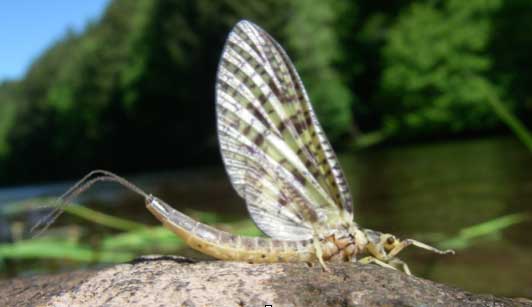A Willowemoc creek green drake.
By Jerry Schoen
We have seen a lot on the TU blog and elsewhere about how climate change is affecting fish and their cold-water habitats, but one under-appreciated concern is that climate change also disrupts the life cycles of aquatic insects. This, in turn, might upset entire freshwater food chains by rendering insects unavailable to fish and other predators at critical times in their lives.
That’s the short version of what’s going on, and it is but one example of phenology—the annual calendars of plants and animals that drive events such as flowers budding, fall foliage and bird migrations. Climate-induced calendar shifts in many plants and animals threaten to knock a wide variety of terrestrial and aquatic ecosystems out of balance. In general, the primary factor is increasing temperature—of the atmosphere, soil, or water as the case may be.
Curious about how temperature affects the life cycle of aquatic insects, I reviewed several dozen scientific papers on the subject. Some reported on lab experiments, others observed natural systems that have exhibited increased water temperature. What follows is a bit of a grab bag of findings from these papers that I thought interesting enough to share.
In general, there are two temperature drivers that move the aquatic insect life cycle along—degree days (the cumulative amount of time an organism spends above a certain minimum level needed for development), and a triggering threshold—i.e. a temperature at which something in the critter’s DNA says “it’s time for a change.” These mechanisms work for the egg-to-larva transition (in scientific terms, this is the true “hatch”), for the larva to pupa stage, and for the larva to adult transition (what anglers call the “hatch” is the “emergence” to a scientist). The relative importance of degree days vs. a temperature trigger varies from species to species.
As with fish, an insect’s metabolic rate speeds up at higher temperatures: it moves faster, breathes faster, eats more and grows faster. Insects can adjust to these increases, which are part of living in a naturally fluctuating environment, but only up to a point. Beyond that point, temperature stresses tend to take over. At higher temperatures the insect requires more oxygen (bad news for nymphs, because oxygen levels decrease in warmer water), more energy to breathe, is more susceptible to diseases, and more vulnerable to parasites.
These factors can lead to several outcomes. Some mayfly, stonefly and caddis species are emerging earlier than in past years, according to a few studies and a lot of anecdotal information. Many emerge smaller because they will stop growing sooner, instead switching over to growing adult body parts. Think of human adolescents, who generally stop growing about the time they start growing body hair and functioning reproductive organs.
Smaller adult insects produce fewer eggs, leading to possible population decline as was found in the British Green Drake (Ephemera Danica). There were also changes in voltinism—the number of broods in a population per year. Danicatypically has a two- or three-year life cycle, but some are now completing the cycle in one year. They may thus lose the buffering capacity a multi-year cycle provides against short-term harmful environmental impacts, such as a one-year drought. And some formerly single-year species are now having two or three broods per year. It’s not clear if this is improves or impairs a species’ evolutionary outlook.
In the lab, salmonfly (Pteronarcys dorsata) larvae were found to go on a feeding frenzy in water temperatures of about 55-90 degrees Farenheit. However, emergence success peaked at around 50-60 degrees, and took a nosedive at higher temperature; in warmer water, they were eating more and dying younger. Those that did emerge successfully lived longest and produced the most eggs at around 50 degrees—in both cases, about twice that of the 60-degree emergers. Several U.S. mayfly species have exhibited similar temperature-related hyperactivity with the same effects on emergence success, adult size, fecundity, and longevity. Burnout happens, even for bugs. One possible factor in shortened adult lifespans is the potential for air and water temperature mismatches. sects who emerge earlier than normal because of warmer winter water temperatures may encounter air temperatures (more variable than water temperature) they can’t survive in.
For many aquatic insect species, males emerge earlier than females. This is thought to increase their chances for successful mating. But warmer water can increase this male-female emergence disparity in some species. If the separation is too great, males will die before getting a chance to mate. This is unfortunate (what is the point of life after all?), and a threat to a species’ very survival.
Diapause is an important survival tool for many species. This refers to a quiescent period of no growth during inhospitable conditions – e.g. temperature extremes, drought, or food unavailability. It usually occurs in the egg stage for aquatic insects, but can also occur for some pupae and even adults. Warmer winter water temperatures can shorten diapause, while warmer summer water temperatures can lengthen it. Although these effects have been documented, there doesn’t yet seem to be a lot of literature that indicates whether changes in diapause length will aid or hinder species’ survival.
Lastly, here’s a curiosity that caught my attention, regarding a secondary impact that might have significant consequences for a certain group of aquatic insects. By comparing streams from the tropics to the artic, one study found that the warmer the water, the greater the proportion of breakdown of leaf material by microbes vs. detritivores. Detritivores feed on dead material such as leaves falling into streams, and include shredders such as stoneflies and some caddisflies, as well as filter feeders (including many mayflies and caddisflies) that feast on the downstream refuse of the shredders. It’s possible that as trout streams warm, these insects will be outcompeted by microbes, and there will be less food available to trout. And good luck trying to tie a fly that’s a good imitation of a glob of microbes.
Some words of caution: it’s not wise to extrapolate too broadly from any of these findings. This is a light survey of a wide body of research and literature, much of which is drawn from experiments that tend to simplify the complexity that is nature and may miss important points. It is also tricky to combine the salient points from different studies into a single conceptual framework that applies to all species: what happens to one species doesn’t necessarily happen to another. Further, many of these papers looked at spring/summer emergers; the dynamics (egg stage in summer, larval growth in winter) for these are the opposite of those for fall emergers, where more research is needed.
Still, aquatic insects are an important part of the complex world of freshwater systems and their sensitivity to temperature may make them especially vulnerable to climate change. Our understanding of how they will respond to climate change is growing, and there are still a lot of questions. But the impacts could be severe, broad and ripple through the entire ecosystem. So let’s not forget the insects as we grapple with climate threats to our trout waters.
Jerry Schoen works at the University of Massachusetts at Amherst and co-founded the River’s Calendar project about climate change and aquatic insect phenology. If you want to get involved, see the River’s Calendarsection of our Angler Science webpage. Several of the studies described above can be found on the resources page of the River’s Calendar web site.



